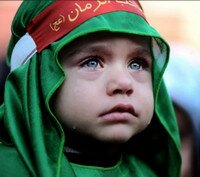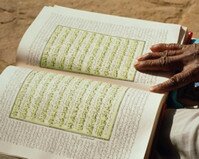
Part 1. Prophet's Malediction
In the Islamic world, the boundaries between yesterday, today and tomorrow are blurred. Here, it may seem that the past is not in the past, it is adjacent to the present and, even more so, it has not got forgiveness. Reviving, it sometimes causes fear and does its murderous work again and again, day after day, year after year — because the time here flows in a different way.
The «Arab Spring» from Tunisia to Bahrain, was beginning as peoples' uprising against their tyrants under the banner of freedom, justice and general welfare. But today, the rebels «up to the ears» are stuck in the vortex of an old feud between the two camps of the Islamic world — Sunnis and Shiites. Almost everywhere, the old feud has revived. The long-standing conflict contributes to the bitter struggle in the Islamic world and the war in Syria shows what an abyss of hatred has got formed between Sunnis and Shiites.
 |
So, when the Sunnis in Syria are against the Alawite regime, Saudi Arabia and Qatar's Sunni come to their aid. And Iran is actively supporting the regime in Damascus with money and weapons.
When the Shiites in Bahrain rebel against their Sunni king, they are supported by Iran and the Syrian regime. But Saudi troops rush to support the Bahraini tyrant. Saudi Arabia very much is afraid of Shiites’ seizing power in Bahrain, as this will result in a real threat for it — to lose the oil which is produced for it by the Shiite minority.
The war of the Assad regime in Syria against the rebels has long had obvious religious traits and outside the country it has sucked various forces into the vortex of the struggle. The regime is being supported by units of the Shia «Hezbollah» from Lebanon and Iran's elite units from the Islamic Revolutionary Guards Corps. On the other hand, the rebels were joined by volunteers from Libya, generously funded by Saudi Arabia and Qatar.
The same front between Sunnis and Shiites is shared today by Iraq. More frequent have become attacks of Sunni radicals. The bloody full-scale war of the Sunni Islamic State against the Kurds and Shiites for expanding the boundaries «of the Arab Caliphate» is on.
Once, during the many years of tough, sometimes bloody dictatorship of Sunni Saddam Hussein's, religion was a private matter. Not because one day Iraqis decided so. Simply because to take the side of either of the parties meant to challenge the state. And this was fraught with danger to life. Even during the eight-year war with Iran, which began in 1980, the brothers in faith on both sides fired at each other. Many Iraqi military servicemen were Shiites, like were the majority of Iranians on the other side of the frontline.
Soon after the coalition forces in 2013, within 19 days had swept away Saddam Hussein's regime, the Iraqi Sunnis unleashed war against the Americans who had removed them from power in the country, thereby having done a favor to the Shiite majority and having broken the age-old way of life of the Sunni minority.
Shiites also fought with the Americans. But first of all fanatical representatives of both groups were killing each other. In Baghdad alone, since 2004, there had been happening several terrorist attacks a day.
At the same time in Lebanon strengthens its positions the Shiite «Hezbollah». Back in 2005, a Sunni King Abdullah II of Jordan warned of the danger of the «Shiite crescent» that would cover the area from Beirut through Baghdad to Tehran. Now the pendulum has swung in the other direction.
In Pakistan, groups of Sunni terrorists are killing Shiites.
Flame of the struggle between Sunnis and Shiites covers Europe too. Thus, in March 2012 in Belgium, Sunni burned a Shiite mosque together with the imam.
But as the saying goes, there is nothing new under the Moon. In the old days, and now alike, it all started with the question of power. When Prophet Muhammad died, he left his followers a problem, which was destined to become a curse for his religion: the question of succession.
 Unlike Jesus Christ, Prophet Muhammad was not just a prophet. He was a prophet and a captain of the host at the same time, the spiritual and political leader of his people, and, accordingly, after his death, a huge gap appeared. It had to be filled somehow.
Unlike Jesus Christ, Prophet Muhammad was not just a prophet. He was a prophet and a captain of the host at the same time, the spiritual and political leader of his people, and, accordingly, after his death, a huge gap appeared. It had to be filled somehow.
The dispute began on whether the successor should belong to the circle of Muhammad's associates or relatives? Ali ibn Abi Talib was Muhammad's cousin and son-in-law. His supporters called themselves «Shi'at Ali» (“Party of Ali”), hence the name «Shiites». But first the victory was won by the other wing, and Ali became caliph only with the fourth attempt.
The first battle for power had lasted for more than twenty years, until at the Battle of Karbala in 680 (modern Iraq's territory), was killed Ali's son — Hussein and his last followers. The line of consanguinity was broken. The outcome of the struggle was clear, «Shi'at Ali» lost. Hussein's death aggravated the contradictions between Sunnis and Shiites, and made them bitter rivals for centuries.
But instead of falling into oblivion, as happened to many branches of Islam, the Shiites became stronger. «Hussein's death was a big explosion, which gave birth to the rapidly growing space of Shiism, — says the expert on the history of Shia Heinz Halm from Thuringia. – To Shiites, Karbala was a turning point and a hub of their faith. The faith, which increased in the situation of defeat and manifesting itself through resistance.»
The line of Imams, descendants of Ali, had lasted for two hundred years. According to tradition, the twelfth Imam of Shiites circa 874 disappeared — was hidden. Shiites believe that someday he will appear in the world again as a devotee of the divine order.
 Much later, in the 16th century, in power in Iran was the Safavid dynasty — fervent followers of the Shiite Islam. It was then that the still existing competition between Shiite Iran and Sunni Arabs began. It happened this way: after sunset of the Ottoman Empire, the Sunni spiritual center has shifted to the Arabian Peninsula, where is Mecca and other holy places of Sunnis, and where the young Abd al-Aziz Al Saud used the religious union of his forefathers, to begin in 1902 the conquest of vast territories of Arabia — the now Kingdom of Saudi Arabia, in the state religion of which became the most fanatical Wahhabi version of the Sunni Islam.
Much later, in the 16th century, in power in Iran was the Safavid dynasty — fervent followers of the Shiite Islam. It was then that the still existing competition between Shiite Iran and Sunni Arabs began. It happened this way: after sunset of the Ottoman Empire, the Sunni spiritual center has shifted to the Arabian Peninsula, where is Mecca and other holy places of Sunnis, and where the young Abd al-Aziz Al Saud used the religious union of his forefathers, to begin in 1902 the conquest of vast territories of Arabia — the now Kingdom of Saudi Arabia, in the state religion of which became the most fanatical Wahhabi version of the Sunni Islam.
Shiites in occupied eastern provinces were declared accursed heretics. Then they began to produce oil. With each borehole, the Saudi Kingdom was turning into one of the world's largest exporters of energy carriers and was giving a tremendous financial support to Wahhabi preachers worldwide. But all large oil fields are located in the East inhabited by Shiites. If the Shiites separate from Saudi Arabia, they will take away with them all its oil wealth. At the same time, to make them citizens with equal rights again, is the same as to declare war to the religious establishment of Saudi Arabia, as well as to broad strata of the population, brought up in the hatred to Shiites. This is also unacceptable! Both options are unacceptable! Where is the way out?
 Islam is aware of the apocalyptic prophecy attributed to Prophet Muhammad by some theologians. It is just an excerpt, the legend of the evil creature Sufyani. One day it will come to sow death and perish among the faithful. And, as predicted by Muhammad, it will come from the bowels of the earth somewhere in the region of Syria (Sham country, the region which is wider than nowadays' Syria) The legend says: «Sufyani from the outskirts of Damascus will arrive in Damascus and will gather two armies, and send one of them to the East (Kufa and vicinity), and the other — to the Medina. Then these troops will march to Mecca for the war against the Mahdi Army, but on the way, near Beida they will be destroyed. Sufyani itself, staying at that time in Palestine, near Bait al-Maqdis (Solomon's Temple) will be captured and beheaded on the stone that stands at the entrance to the Temple...»
Islam is aware of the apocalyptic prophecy attributed to Prophet Muhammad by some theologians. It is just an excerpt, the legend of the evil creature Sufyani. One day it will come to sow death and perish among the faithful. And, as predicted by Muhammad, it will come from the bowels of the earth somewhere in the region of Syria (Sham country, the region which is wider than nowadays' Syria) The legend says: «Sufyani from the outskirts of Damascus will arrive in Damascus and will gather two armies, and send one of them to the East (Kufa and vicinity), and the other — to the Medina. Then these troops will march to Mecca for the war against the Mahdi Army, but on the way, near Beida they will be destroyed. Sufyani itself, staying at that time in Palestine, near Bait al-Maqdis (Solomon's Temple) will be captured and beheaded on the stone that stands at the entrance to the Temple...»
Recent events in Iraq once again have stirred up the theme of the Hidden Imam Mahdi and his imminent arrival, and the emergence of Sufyani is a sure and must feature of his coming... ISIS?!!
What Divides Shiites and Sunnis?
 Middle East. Gulf zone. Arabs stubbornly call it the Arabian Gulf. We offer to return to the recent developments in the Kingdom of Saudi Arabia (KSA).
Middle East. Gulf zone. Arabs stubbornly call it the Arabian Gulf. We offer to return to the recent developments in the Kingdom of Saudi Arabia (KSA).
October 26, 2012 Saudi Arabia's King Abdullah ibn Abdilaziz received the Head of the State Security Service and Commander of the Armed Forces of the KSA Supreme Mufti Abdul Aziz bin Abdullah Al Ash-Sheikh. The conversation turned out to be quite difficult for both of them. It was mostly about mass protests of the Shiite youth in the fall of 2011 in the town of El Avamiyya (Eastern Province of KSA). The occasion was the arrest of a religious radical Sheikh Nimr An-Nimr, who called on the faithful to protest against Saudi troops' entry to Bahrain and not to observe mourning for the death of the heir to the throne, Prince Nayef bin Abdul Aziz, whom Sheikh called the Shiites' enemy.
 The monarch repeated several times about vigilance in the face of «threatening the homeland unrests, instigators of which keep trying to destroy the unity of the country». Supreme Mufti was forced to admit that Shiite youths' sporadic acts of violence continue. The Saudi press has unanimously blamed for the unrest the Islamic Republic of Iran, which «has failed in Bahrain and is losing Syria».
The monarch repeated several times about vigilance in the face of «threatening the homeland unrests, instigators of which keep trying to destroy the unity of the country». Supreme Mufti was forced to admit that Shiite youths' sporadic acts of violence continue. The Saudi press has unanimously blamed for the unrest the Islamic Republic of Iran, which «has failed in Bahrain and is losing Syria».
Almost a year later, in August 2012, in Mecca, at the Summit of the Organization of Islamic Cooperation, the King of KSA proposed to create a Centre of Islamic religious dialogue, with its headquarters in Riyadh, which would focus on solving domestic problems associated with political unrests, but not on «achieving agreement on matters of faith». This announcement implied that the King of Saudi Arabia, with the support of other monarchs of the Gulf region, has made some concession to the Shiites, having proclaimed Shi'ism madhhab, equal to law schools of Sunni Islam, and the negotiations of the King and President of Iran, Mahmoud Ahmadinejad had to stop the «Iranian interference in the internal affairs of Saudi Arabia». But at this, Sunni Saudis under no circumstances were going to actually put up with Shia-Iranians. The dominance of the Wahhabi interpretation of the Hanbali madhhab remains unshakable in the Kingdom, contradictions with Iran, including at the regional level, are not gone yet.
Now it is appropriate to clarify who the Sunnis are, why they do not want to recognize the Shiites equal to themselves and what Hanbali madhhab is about.
Let's start with the fact that the Islamic faith teaches that all people on the earth are equal. Here we should remember that the Prophet said about equality: «There is no difference between an Arabs and non-Arabs, between a white and a black, and people are as equal as the teeth of the comb.»
 The first split among the Muslims occurred in the middle of the 7th century as a result of political struggle, when in 656, following the assassination of the third Righteous Caliph Uthman ibn Affan was elected Prophet Muhammad's son-in-law, Caliph Ali ibn Abi Talib. Suspecting Caliph Ali of involvement in the murder of Caliph Uthman, the governor of Syria Mu'awiyah ibn Abi Sufyan (remember the prediction about Sufyani?) refused to swear allegiance to him, and due to this, in 657 the battle of Siffin took place. During the battle, when Mu'awiyah's forces were running out, he went to the trick, forcing Ali ibn Abu Talib to stop fighting and start peace talks. Some historians claim that Mu'awiyah ordered his men to put onto spears sacred to all Muslims scrolls of the book of the Koran and Ali ordered to stop the fight. Ali's irresoluteness provoked an outrage among his supporters, and 12 thousand men left his army and later settled in Iraq. Those warriors who had left Ali after the battle of Siffin, became known as the Kharijites (from Arabic. خوارج – those who spoke against, who left).
The first split among the Muslims occurred in the middle of the 7th century as a result of political struggle, when in 656, following the assassination of the third Righteous Caliph Uthman ibn Affan was elected Prophet Muhammad's son-in-law, Caliph Ali ibn Abi Talib. Suspecting Caliph Ali of involvement in the murder of Caliph Uthman, the governor of Syria Mu'awiyah ibn Abi Sufyan (remember the prediction about Sufyani?) refused to swear allegiance to him, and due to this, in 657 the battle of Siffin took place. During the battle, when Mu'awiyah's forces were running out, he went to the trick, forcing Ali ibn Abu Talib to stop fighting and start peace talks. Some historians claim that Mu'awiyah ordered his men to put onto spears sacred to all Muslims scrolls of the book of the Koran and Ali ordered to stop the fight. Ali's irresoluteness provoked an outrage among his supporters, and 12 thousand men left his army and later settled in Iraq. Those warriors who had left Ali after the battle of Siffin, became known as the Kharijites (from Arabic. خوارج – those who spoke against, who left).
In 661, Caliph Ali ibn Abi Talib was gravely wounded by Kharijite Ibn Muljam, after that the majority of Muslims recognized Caliph Mu'awiyah, swore allegiance to him, but a small part remained true to Ali and decided that power in the Caliphate should belong to his descendants.

So Muslims got divided into Sunnis (Arabic. أهل السنة والجماعة — Ahlu-Sunnah Wa al-Jama'ah), who recognized as legitimate the power of the rebel Mu'awiyah and the Umayyad dynasty, and Shiites (Arabic. شيعة — Shi'a «supporters of Ali”), who supported the Prophet's cousin and son-in-law Caliph Ali and who are still sure that the power in the Caliphate should belong only to Ali's descendants, and did not join any of the groups of the Kharijites.
 |
| Photo http://islamic-313.blogspot.com/ |
Sunnis — today they are the overwhelming majority of Muslims (85-87 %) in most of the Islamic countries (Middle East, North Africa, Central and South Asia and so on). Their main distinguishing feature is their commitment in legal issues to one of the four generally recognized Sunni law schools (madhhabs of fiqh) and in belief system following asaris, asharis or maturidis school (madhhab aqidah).
Sunnis also include Salafists (Saudi Arabia, Qatar, Kuwait, and United Arab Emirates) and Sufis.
Note: The Sunnis — literally — Muslims, guided by «the Sunnah». The Sunnah explains (interprets) Muslims' holy book — the Koran — and complements it. That is why traditional followers of Islam consider following «Sunnah» the main content of the life of every true Muslim. At this, it is often a question of literal perception of the sacred book's regulations, without any modifications.
 |
|
Photo http://www.azattyq.org/ |
Shiites — the second largest group of Muslims (10-13 %). Traditionally Shiites are divided into moderate the Twelver Shiite or Twelvers (Iran, Azerbaijan, Bahrain, Iraq and Lebanon) and Zaidi (Yemen, Saudi Arabia, Iran and Iraq), as well as the extreme Shia Ismailis, Alawites (Syria, Turkey and Lebanon).
According to estimates of the analytical center Pew Research Center, in 2009 the majority of Shiites in the world (68-80 %) lived in four countries: Iran, Pakistan, India and Iraq. At this, Iraq is home to 40 % of the total number of Shiites around the world.
Kharijites – Kharijites' religious views largely coincide with those of Sunnis, but Kharijites recognize as legitimate only the first two Caliphs — Abu Bakr and Umar ibn al-Khattab, not recognizing Usman Ali and all the rest.
Among Kharijites there were several sects, but most of them have either disappeared or are represented by small groups. In today's world Kharijites are represented by ibadis constituting the majority of the population of Oman.
Madhhab — the religious and law school. Each Islamic sect has its own law school (madhhab) with peculiar only to it methodology of making Sharia decisions.

 The primary sources of all Madhhabs are the Koran and Sunnah (the set of rules and practices, based on the example of Prophet Muhammad's life). In different madhhabs it can differ significantly due to the difference between collections of hadiths (Prophet and his companions' sayings).
The primary sources of all Madhhabs are the Koran and Sunnah (the set of rules and practices, based on the example of Prophet Muhammad's life). In different madhhabs it can differ significantly due to the difference between collections of hadiths (Prophet and his companions' sayings).
The secondary sources of Sharia include such things as:
- Ijma — unanimous point of view of scientists;
- Qiyas — reasoning by analogy;
- Istihsan — legal exception;
- Istihsab — legal presumption;
- Maslyaha Mursal — general good/benefit;
- Urf (adat) – tradition, custom
- Saddu Zarai — prevention of harm, etc..
The difference in the priority of selection of secondary sources of Islamic law and methodology of decision-making has led to some differences in legal matters among Muslims.
Today there are four main Sunni madhhabs in the world: Hanafi, Shafi'i, Maliki and Hanbali(Saudi Arabia).
Shiites also have several major schools of thought: Ja'fari, Zaidi, Ibadi, etc.
In the Koran, for all the faithful are prescribed norms of morality, which should be strictly observed:
- Honesty (al-Sidk);
- Reliability and loyalty (al-Amana);
- Sincerity (al-Ikhlas);
- Politeness, correctness, and other rules of conversation and polemic (adab al-Hadith);
- Expulsion of anger, hatred, envy, and other vices from the heart (salyamat al-Sadr);
- Moral and physical strength (al-Kuvva);
- Tolerance and being able to forgive (al-Hilmi and al-Safh);
- Modesty (al-Haya);
- Dignity and self-esteem (al-Issa)
- Search for wisdom and knowledge, need for self-education and self- improvement (al-'Ilm);
- Desire to devote all one's time and life to good deeds (al-Hirs ala al-Waqt);
- Generosity (al-Jude val-Karam);
- Patience (al-Sabr);
- Wise management of one's assets (al-Iqtisadi);
- Sociability, kind attitude towards others (al-Taaruf);
- Passion for cleanliness and beauty (en-Nazafa Vattadzhmmul);
- Aversion to evil and sin (Tadzhannub al-Aatam wal Shubuhat).
Each of these values is described in the Qur'an and Sunnah, either directly or through examples, parables and sayings of prophets.
All believers live under the laws of Islam, collected in Sharia.
Sharia (Arabic. شريعة — the right way, a course of action) – Polysemic term: a set of divine commands and prohibitions; Divine Law, based on the verses of the Qur'an and Sunnah; religious requirements relating to practices of Muslims; religion as a whole.
Sources of interpretation of Islamic law (Sharia) do not establish any differences between the Shia and Sunni Islam. But differences between the two movements arise as a consequence of the interpretation of hadiths (Prophet and his companions' statements).
In the case of the Shiites, interpretation includes Imams' statements. In Shia Islam, the imams are not just masters of prayers, but they also are carriers of supernatural knowledge and holders of undisputed authority.
This is the main reason for their disagreements with the Sunnis.
 The Iranian revolution of 1979 caused severe anxiety because of the possible spread of the influence of Shiites in the Gulf region and Pakistan. Saudi Arabia actively supported the Sunni doctrine through generous subsidies to local leaders (such as, for example, Pakistani President Mohammad Zia ul-Haq) in order to counter Shiites' influence through expanding the network of Islamic schools — madrassas. The Saudis wanted these schools to be sympathetic to Sunni Islam and to support the Wahhabi interpretation of it. In their tough interpretations of the Koran, Wahhabis call to active actions against the unbelievers and especially against the Shiites, whom they consider notorious heretics. Later in Pakistani madrassas originated and gained momentum the Taliban movement.
The Iranian revolution of 1979 caused severe anxiety because of the possible spread of the influence of Shiites in the Gulf region and Pakistan. Saudi Arabia actively supported the Sunni doctrine through generous subsidies to local leaders (such as, for example, Pakistani President Mohammad Zia ul-Haq) in order to counter Shiites' influence through expanding the network of Islamic schools — madrassas. The Saudis wanted these schools to be sympathetic to Sunni Islam and to support the Wahhabi interpretation of it. In their tough interpretations of the Koran, Wahhabis call to active actions against the unbelievers and especially against the Shiites, whom they consider notorious heretics. Later in Pakistani madrassas originated and gained momentum the Taliban movement.
Thus, the Quran and the Sunnah write how a faithful should behave. But in reality the situation is far from it. Antipathies between communities within Islam are more common than even between Islam itself and other religious beliefs and their followers.
In some countries of the world, theological and cultural disagreements between Sunnis and Shiites lead to open violence and bloodshed.
To be continued

